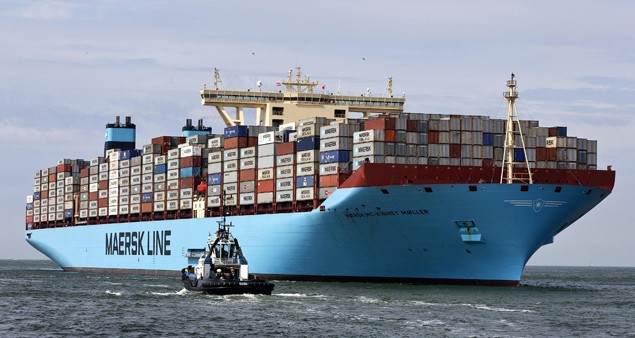Firms in Fed’s Beige Book Fret Over Any Lengthy Baltimore Port Closure
(Bloomberg) — The closure of one of the East Coast’s busiest ports after the collapse of Baltimore’s Francis Scott Key Bridge has so far not led to broad price increases,...


An aerial view of the MV Maersk Mc-Kinney Moller, the world’s biggest container ship, as it arrives at the harbour of Gdansk August 21, 2013. REUTERS/Renata Dabrowska/
By Mike Wackett
The success of Maersk Line in cutting its unit cost by a massive $390 per 40ft unit in the third quarter was the silver bullet that put an ocean of competitive market advantage between the Danish carrier and its rivals.
This equated to a 13% year-on-year reduction in costs against a backdrop of a 12.2% decrease in average freight rates.
“Vessel network efficiencies” is the preferred term from Maersk executives, and relates primarily to 7.8% lower bunker consumption in the quarter, compared with the same period in 2012; and secondly to the 17.1% decrease in its fuel bill – from $1.6bn to $1.3bn – which was also helped by a 10.5% fall in average bunker prices.
The importance of fuel costs to the bottom line of ocean carriers cannot be underestimated – Maersk Line’s profit would have been more than halved if not for these savings.
Indeed, given the massive decline in freight rates over the first three months of 2013 – repeated in the latter weeks of Q3 on the Asia-Europe trade – it is fortunate for carriers posting red-inked results that bunker fuel has remained at around $600 per tonne for most of the year. In several months of 2012 it reached almost $700.
Maersk’s new Triple-E ships burn a miserly 160 tonnes per day at sea – some 30% less than the current 13,000 teu workhorses deployed on Asia-Europe – although a $100 hike in bunker prices would add around $16,000 a day to their operating costs.
Such a hike across Maersk’s 576-ship fleet becomes a profitability game-changer.
Nonetheless, to finalise budgets, carriers must know their costs – particularly fuel, which can be 40-60% of the operating costs of a vessel.
Of some comfort to the carriers is that the cost of a tonne of Rotterdam-sourced IFO 380 is still below the $600 watershed, at around $570, and is said, reassuringly for carriers, to have “little direction”.
Oil prices, however, are notoriously hard to forecast, even three months ahead, as they are ultra-sensitive to global shocks such as the Syrian crisis, Iran, Egypt and Libya, as well as the perception of stronger or weaker consumer demand.
A poll of expert energy analysts would reveal the price of a barrel of oil could be heading up to $150 or down to $80 – from the current $108 for Brent Crude – depending on the individual view of supply and demand.
It follows that ocean carriers compiling their budgets for 2014 will have to make an assumption that oil prices will remain stable.
Having entered fuel costs within the budget – a cost over which they have little influence other than deploying smarter sailing and slow steaming techniques – they should turn their attentions to factors within their control: cellular capacity and freight rate erosion.
The carriers must make GRIs stick this time – it is their last chance before possibly doing irreparable damage to 2014 budgets.
Join the gCaptain Club for curated content, insider opinions, and vibrant community discussions.


Join the 105,960 members that receive our newsletter.
Have a news tip? Let us know.
Access exclusive insights, engage in vibrant discussions, and gain perspectives from our CEO.
Sign Up




Maritime and offshore news trusted by our 105,960 members delivered daily straight to your inbox.



Essential news coupled with the finest maritime content sourced from across the globe.
Sign Up